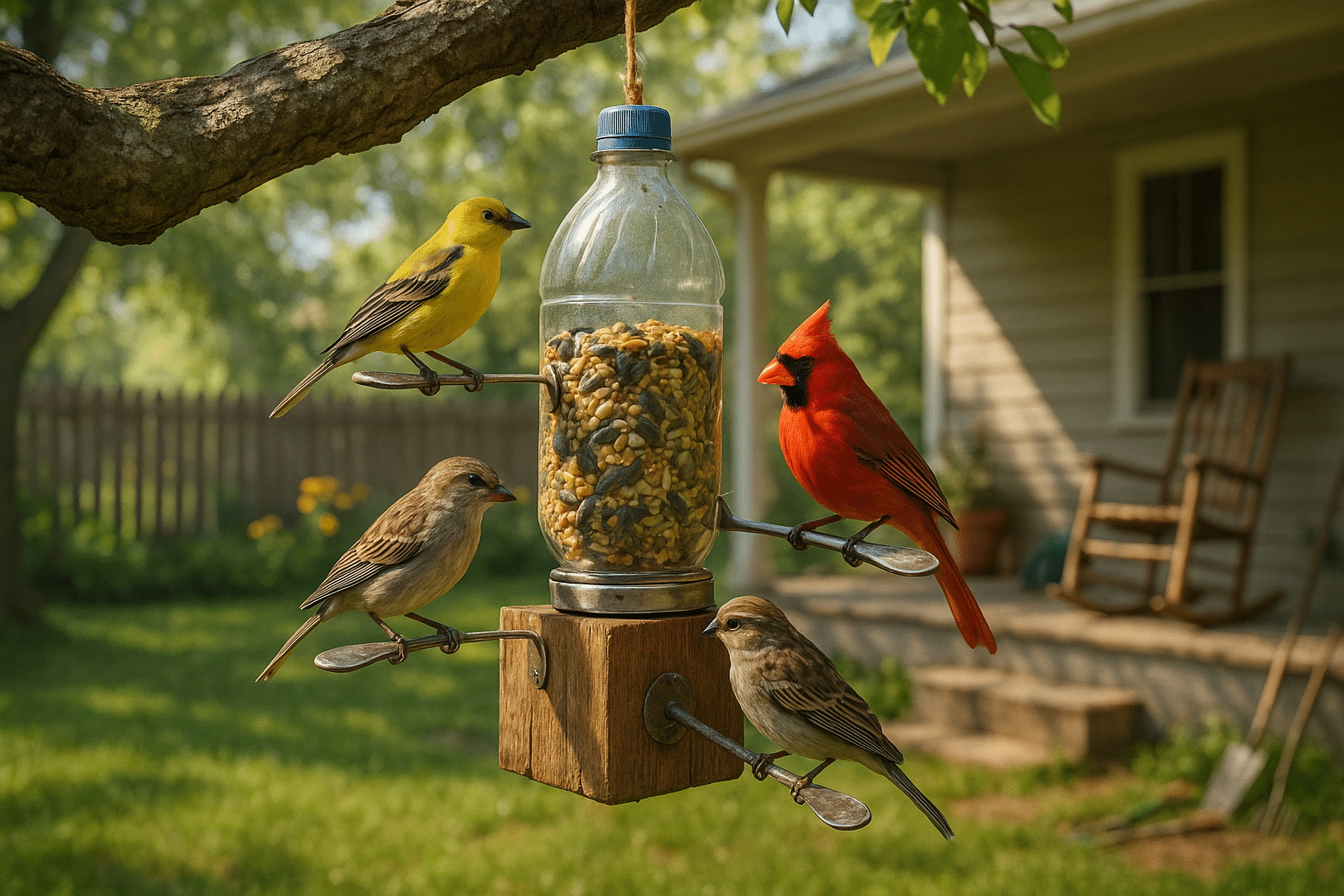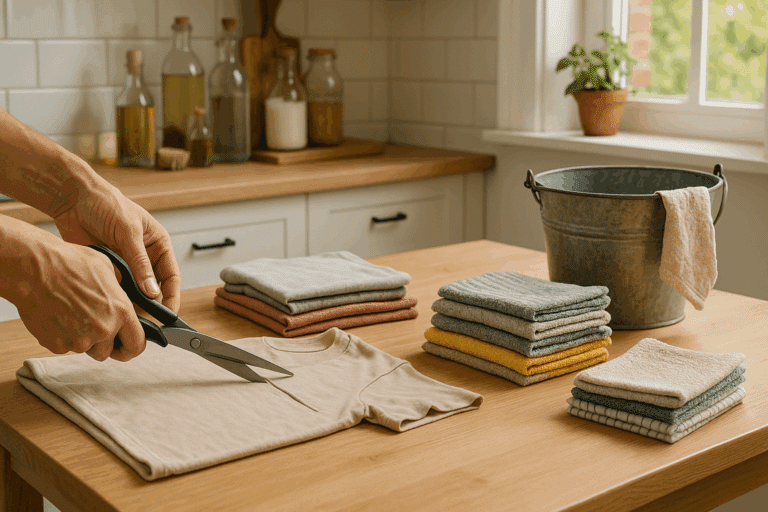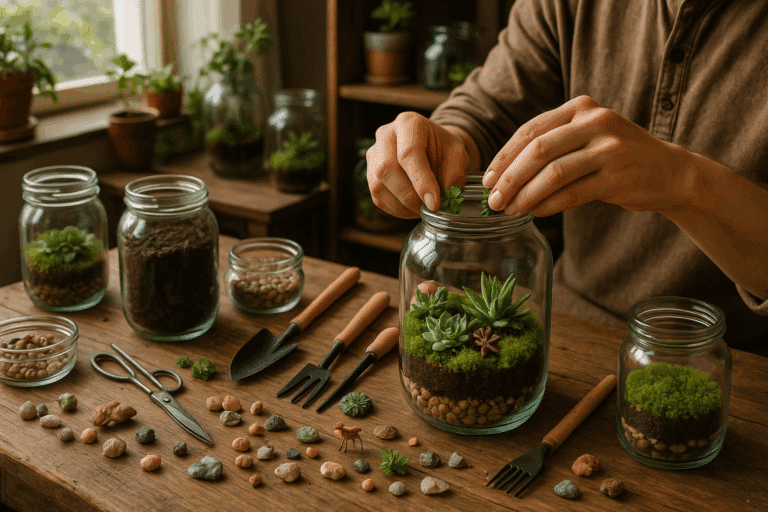An early morning sun is rising, casting warm and inviting beams of light across your lawn. The air is crisp, and nature is awakening. Suddenly, a flapping sound breaks the serenity. It’s a colorful bird, gracefully perching on a structure in your garden. It’s your DIY bird feeder, a welcoming oasis for your feathered friends, made from mere household scraps. A sight to behold, isn’t it? 🐦
In a world that’s increasingly digital and disconnected from nature, engaging in a DIY project like creating a bird feeder can provide a much-needed retreat. It allows you to reconnect with nature and contribute to local biodiversity in a small yet meaningful way. 🌿 The best part? You don’t need to be a DIY guru or an ornithologist to embark on this exciting journey!
Now, you might be wondering, “How exactly can I turn my household scraps into a feathered friend oasis?” This is where the fun begins. I will guide you through the process, explaining each step in a clear, easy-to-understand manner. Before you know it, you will have created a sanctuary that our flying friends will flock to.
What’s In Store For You
In this comprehensive guide, we will first dive into the essential considerations for constructing a bird feeder. We’ll discuss the importance of choosing the right materials to ensure durability and safety for the birds. Plus, we’ll touch upon how to design a feeder that’s easy for birds to access but hard for predators to invade. 🦅
Next, we’ll examine a variety of household scraps that can be cleverly repurposed into bird feeders. You’ll be surprised how everyday items, often destined for the trash, can serve a higher purpose. Think tin cans, old breadboards, or even a disused teapot! I’ll provide detailed instructions and helpful illustrations to guide you through each project.
After that, we’ll delve into the world of bird nutrition. After all, a bird feeder is not just a place for birds to hang out—it should provide them with essential nutrients. We’ll explore what foods attract specific bird species and which ones to avoid to prevent harming our winged visitors.
Why This Matters
Building a DIY bird feeder isn’t just a fun and fulfilling project. It’s an opportunity to learn about different bird species and their habits. More than that, it’s a chance to take action in supporting our local wildlife. Bird populations worldwide are in decline due to habitat loss, pollution, and climate change. By providing a safe place for birds to eat and rest, you’re doing your part to help. 🕊️
This guide is much more than a technical manual. It’s a call to reconnect with nature, to nurture our environment, and to bring a little more beauty and joy into our lives. So, are you ready to embark on this adventure? Let’s get started on creating your very own DIY bird feeder—a slice of paradise for your feathered friends!
Stay tuned, because by the end of this comprehensive guide, you’ll be an expert in transforming everyday household items into an oasis for our feathered friends.
Transforming Scraps into Birdie Paradise
Ever wondered what to do with those random household scraps that just keep piling up? Have you ever thought of turning these “waste” materials into a haven for our feathered friends? It’s not only a fun and creative activity but also a great way to help support local birdlife. Now, let’s dive into the art of making a DIY bird feeder.
Before we begin, it’s important to understand that bird feeders are more than just decorative garden elements. They provide necessary sustenance for birds, especially during periods of food scarcity. The more bird-friendly your yard is, the greater the variety of birds it can attract. For a visual guide on this process, check out the informative video ‘DIY Bird Feeder Tutorial’ by The Nature Network on YouTube.
Let’s get started by understanding the key components of a bird feeder, the materials required, and the step-by-step guide on how to put it all together.
Key Components of a DIY Bird Feeder
When constructing a bird feeder, there are three main components to consider: the structure, the food holder, and the perch. The structure is the main body of the feeder, usually a container or platform where food is placed. The food holder is the section that actually contains the bird food, while the perch provides a resting place for the birds as they feed.
In addition, it’s important to choose the right location for your bird feeder. It should be in a quiet and safe spot, away from predators and excessive noise. The feeder should be at a height that is convenient for the birds but also allows you to easily refill it.
Let’s examine the materials that can be used for each of these components. While there are no strict rules, the following table provides a comparison of various materials based on their suitability and ease of use.
| Component | Material Options | Suitability |
| Structure | Plastic containers, wooden boxes, metal cans | All these materials are easy to work with and durable. Wood and metal may require more tools and skills to shape. |
| Food Holder | Bottle caps, small dishes, shells | These should be shallow to allow birds easy access to the food. Bottle caps and shells can be painted for aesthetic appeal. |
| Perch | Sticks, wooden spoons, straws | These should be sturdy and well-secured. Wooden spoons can serve as both a perch and a food holder. |
With these insights, let’s move on to the actual process of constructing the bird feeder.
The Art of Assembling: A Step-by-Step Guide
Now that we have the components and materials sorted, it’s time to put them all together. Here are the step-by-step instructions to create your very own bird feeder from household scraps.
- Begin by cleaning your chosen structure and drying it thoroughly.
- Next, secure your food holder to the structure. This could involve gluing a bottle cap to a wooden box or attaching a small dish to a plastic container. Ensure that it’s sturdy enough to hold the bird food.
- Attach the perch to the structure. Again, make sure it’s firm and well-balanced to accommodate the birds.
- Finally, fill your food holder with bird food. Be sure to research what food is best for the types of birds in your area.
Now, sit back and enjoy the sight of your feathered friends enjoying their new feeding spot. Don’t forget to maintain the bird feeder by cleaning it regularly and refilling it with food. This will ensure that it remains an attractive and safe spot for the birds.
Building a DIY bird feeder is not only a fun and engaging activity but also a great way to recycle household scraps. Plus, it allows you to contribute to bird conservation in your own little way. So go ahead, give it a try, and let your creativity take flight!

Conclusion
In conclusion, we have journeyed through a comprehensive exploration of a critical topic that sits at the heart of both IT and engineering – the role and significance of Software Engineering. From the outset, we have defined and dissected the core facets of this domain, placing emphasis on its varied components, its real-world applications, and the far-reaching benefits it brings to our increasingly digitalized world.
Let’s rewind and revisit some of the significant points we’ve covered in this enriching discourse. We began by delving into the basics of Software Engineering, offering a clear, concise understanding of its role in designing, developing, and maintaining software systems. We explored the significance of quality assurance in this field, highlighting its impact on enhancing the functionality, reliability, and performance of software applications.
We then moved on to the various methodologies used in Software Engineering, including the Waterfall model, the Agile approach, and DevOps practices. Through these discussions, we underscored the importance of choosing the right model based on the specific requirements of a project, setting the stage for efficiency, productivity, and success.
Our exploration also touched on the critical role of data structures and algorithms in Software Engineering. We broke down the complexities of these concepts, shedding light on how they drive the development of efficient software systems. We emphasized how an in-depth understanding of these components can be a game-changer in solving complex problems and optimizing software performance.
Now, after laying out these concepts in plain language, it’s clear that Software Engineering is an essential pillar in the field of IT and engineering. Not only does it underpin the development and execution of software systems, but it also fosters a systematic, disciplined approach to software design and management.
So, where does this leave us? Whether you are a seasoned professional or an aspiring newbie in the realm of Software Engineering, this comprehensive guide serves as a valuable resource, aiding in your continued growth and development. As you move forward, remember, knowledge is power. Keep learning, keep exploring, and keep pushing the boundaries of what you think you know about Software Engineering.
Remember to share this knowledge with others in your circle. Pass along this article to your colleagues, peers, or anyone interested in the intricacies of Software Engineering. Leave your thoughts in the comment section below – we’d love to hear your perspective on the subject. 😉
Be inspired. Be curious. Keep learning. Here is a helpful link for further research on the topic.
References: Association for Computing Machinery (ACM), Elsevier, Institute of Electrical and Electronics Engineers (IEEE).
And as always, stay tuned for more insightful articles on a myriad of topics within the realm of IT and engineering. Stay curious! Stay informed! 👋
Tags: #SoftwareEngineering, #IT, #Engineering, #DataStructures, #Algorithms



